BSBFIM601 Manage Finances: Legislation, Budget Analysis & Cash Flow
VerifiedAdded on 2023/05/28
|50
|17584
|118
Homework Assignment
AI Summary
This assignment focuses on financial management, specifically addressing key Australian legislation and conventions relevant to organizational finance. It covers the Australian Securities and Investments Commission Act 2001, Corporations Act 2001, and the Competition and Consumer Act 2010, detailing their purpose and relevance to financial operations. The assignment also includes a profit budget for 2018/19, broken down by quarter, analyzing revenue, cost of goods sold, gross profit, expenses, and net profit. Additionally, it provides a cash flow analysis related to GST for the same period. Desklib provides a platform for students to access similar solved assignments and past papers for further study.
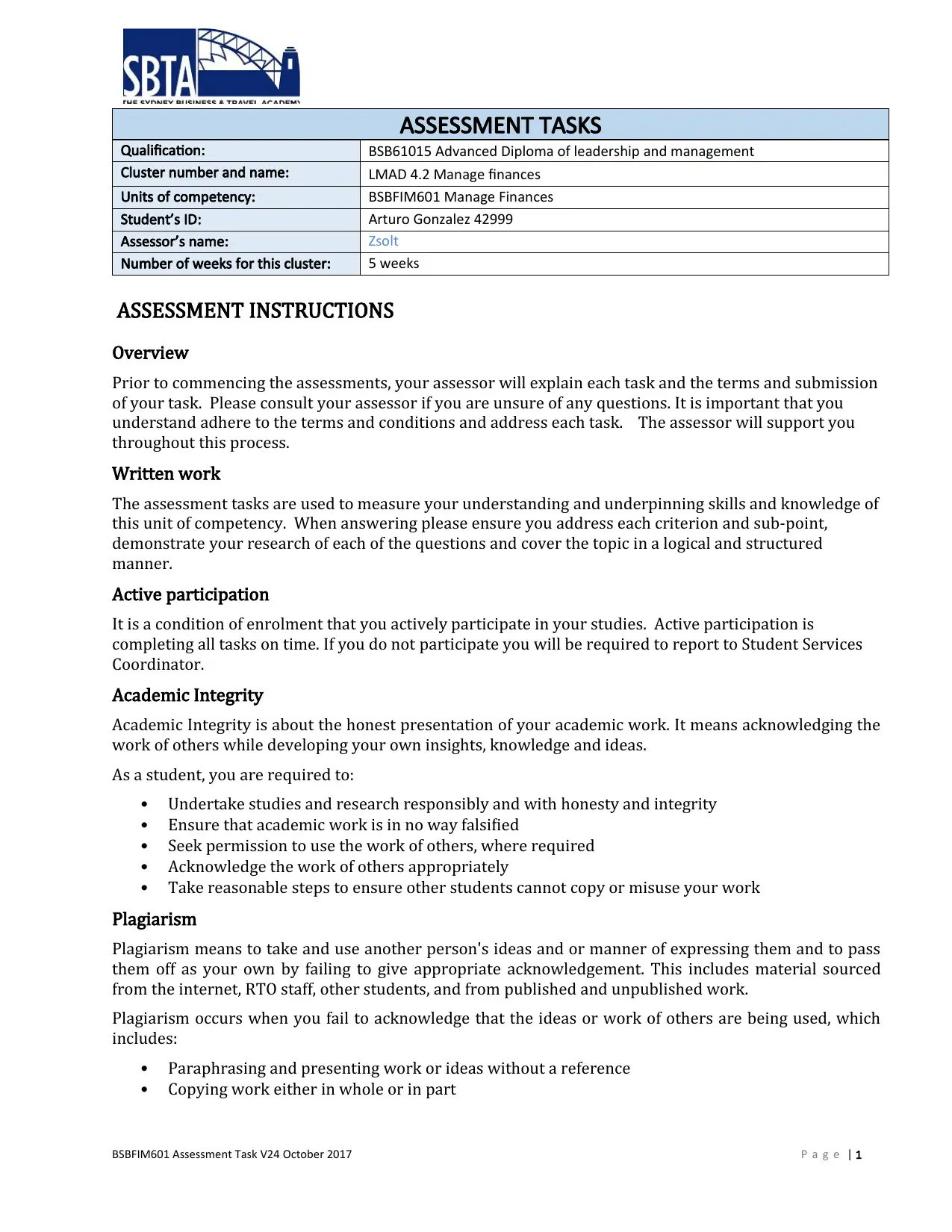
ASSESSMENT TASKS
Qualification: BSB61015 Advanced Diploma of leadership and management
Cluster number and name: LMAD 4.2 Manage finances
Units of competency: BSBFIM601 Manage Finances
Student’s ID: Arturo Gonzalez 42999
Assessor’s name: Zsolt
Number of weeks for this cluster: 5 weeks
ASSESSMENT INSTRUCTIONS
Overview
Prior to commencing the assessments, your assessor will explain each task and the terms and submission
of your task. Please consult your assessor if you are unsure of any questions. It is important that you
understand adhere to the terms and conditions and address each task. The assessor will support you
throughout this process.
Written work
The assessment tasks are used to measure your understanding and underpinning skills and knowledge of
this unit of competency. When answering please ensure you address each criterion and sub-point,
demonstrate your research of each of the questions and cover the topic in a logical and structured
manner.
Active participation
It is a condition of enrolment that you actively participate in your studies. Active participation is
completing all tasks on time. If you do not participate you will be required to report to Student Services
Coordinator.
Academic Integrity
Academic Integrity is about the honest presentation of your academic work. It means acknowledging the
work of others while developing your own insights, knowledge and ideas.
As a student, you are required to:
• Undertake studies and research responsibly and with honesty and integrity
• Ensure that academic work is in no way falsified
• Seek permission to use the work of others, where required
• Acknowledge the work of others appropriately
• Take reasonable steps to ensure other students cannot copy or misuse your work
Plagiarism
Plagiarism means to take and use another person's ideas and or manner of expressing them and to pass
them off as your own by failing to give appropriate acknowledgement. This includes material sourced
from the internet, RTO staff, other students, and from published and unpublished work.
Plagiarism occurs when you fail to acknowledge that the ideas or work of others are being used, which
includes:
• Paraphrasing and presenting work or ideas without a reference
• Copying work either in whole or in part
BSBFIM601 Assessment Task V24 October 2017 P a g e | 1
Qualification: BSB61015 Advanced Diploma of leadership and management
Cluster number and name: LMAD 4.2 Manage finances
Units of competency: BSBFIM601 Manage Finances
Student’s ID: Arturo Gonzalez 42999
Assessor’s name: Zsolt
Number of weeks for this cluster: 5 weeks
ASSESSMENT INSTRUCTIONS
Overview
Prior to commencing the assessments, your assessor will explain each task and the terms and submission
of your task. Please consult your assessor if you are unsure of any questions. It is important that you
understand adhere to the terms and conditions and address each task. The assessor will support you
throughout this process.
Written work
The assessment tasks are used to measure your understanding and underpinning skills and knowledge of
this unit of competency. When answering please ensure you address each criterion and sub-point,
demonstrate your research of each of the questions and cover the topic in a logical and structured
manner.
Active participation
It is a condition of enrolment that you actively participate in your studies. Active participation is
completing all tasks on time. If you do not participate you will be required to report to Student Services
Coordinator.
Academic Integrity
Academic Integrity is about the honest presentation of your academic work. It means acknowledging the
work of others while developing your own insights, knowledge and ideas.
As a student, you are required to:
• Undertake studies and research responsibly and with honesty and integrity
• Ensure that academic work is in no way falsified
• Seek permission to use the work of others, where required
• Acknowledge the work of others appropriately
• Take reasonable steps to ensure other students cannot copy or misuse your work
Plagiarism
Plagiarism means to take and use another person's ideas and or manner of expressing them and to pass
them off as your own by failing to give appropriate acknowledgement. This includes material sourced
from the internet, RTO staff, other students, and from published and unpublished work.
Plagiarism occurs when you fail to acknowledge that the ideas or work of others are being used, which
includes:
• Paraphrasing and presenting work or ideas without a reference
• Copying work either in whole or in part
BSBFIM601 Assessment Task V24 October 2017 P a g e | 1
Paraphrase This Document
Need a fresh take? Get an instant paraphrase of this document with our AI Paraphraser
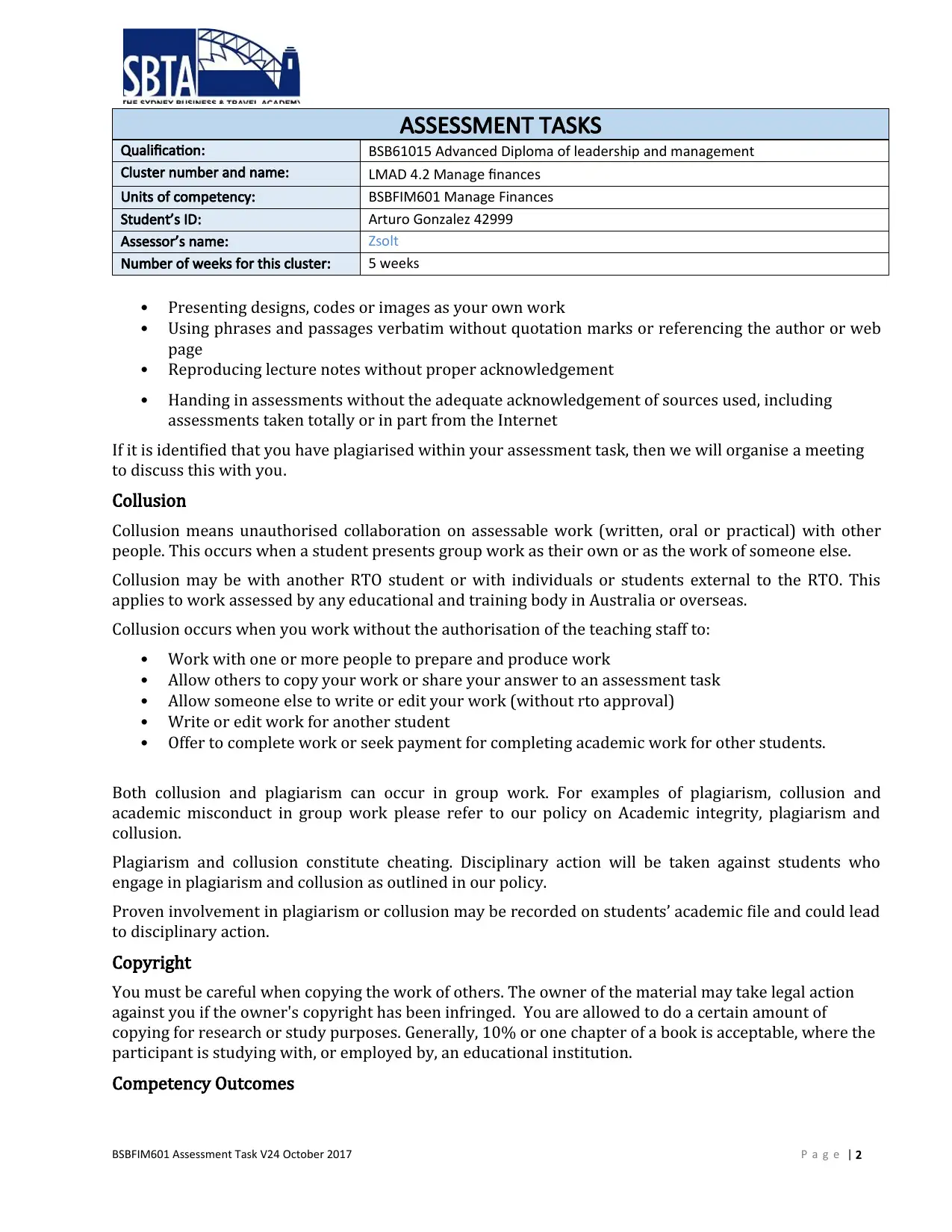
ASSESSMENT TASKS
Qualification: BSB61015 Advanced Diploma of leadership and management
Cluster number and name: LMAD 4.2 Manage finances
Units of competency: BSBFIM601 Manage Finances
Student’s ID: Arturo Gonzalez 42999
Assessor’s name: Zsolt
Number of weeks for this cluster: 5 weeks
• Presenting designs, codes or images as your own work
• Using phrases and passages verbatim without quotation marks or referencing the author or web
page
• Reproducing lecture notes without proper acknowledgement
• Handing in assessments without the adequate acknowledgement of sources used, including
assessments taken totally or in part from the Internet
If it is identified that you have plagiarised within your assessment task, then we will organise a meeting
to discuss this with you.
Collusion
Collusion means unauthorised collaboration on assessable work (written, oral or practical) with other
people. This occurs when a student presents group work as their own or as the work of someone else.
Collusion may be with another RTO student or with individuals or students external to the RTO. This
applies to work assessed by any educational and training body in Australia or overseas.
Collusion occurs when you work without the authorisation of the teaching staff to:
• Work with one or more people to prepare and produce work
• Allow others to copy your work or share your answer to an assessment task
• Allow someone else to write or edit your work (without rto approval)
• Write or edit work for another student
• Offer to complete work or seek payment for completing academic work for other students.
Both collusion and plagiarism can occur in group work. For examples of plagiarism, collusion and
academic misconduct in group work please refer to our policy on Academic integrity, plagiarism and
collusion.
Plagiarism and collusion constitute cheating. Disciplinary action will be taken against students who
engage in plagiarism and collusion as outlined in our policy.
Proven involvement in plagiarism or collusion may be recorded on students’ academic file and could lead
to disciplinary action.
Copyright
You must be careful when copying the work of others. The owner of the material may take legal action
against you if the owner's copyright has been infringed. You are allowed to do a certain amount of
copying for research or study purposes. Generally, 10% or one chapter of a book is acceptable, where the
participant is studying with, or employed by, an educational institution.
Competency Outcomes
BSBFIM601 Assessment Task V24 October 2017 P a g e | 2
Qualification: BSB61015 Advanced Diploma of leadership and management
Cluster number and name: LMAD 4.2 Manage finances
Units of competency: BSBFIM601 Manage Finances
Student’s ID: Arturo Gonzalez 42999
Assessor’s name: Zsolt
Number of weeks for this cluster: 5 weeks
• Presenting designs, codes or images as your own work
• Using phrases and passages verbatim without quotation marks or referencing the author or web
page
• Reproducing lecture notes without proper acknowledgement
• Handing in assessments without the adequate acknowledgement of sources used, including
assessments taken totally or in part from the Internet
If it is identified that you have plagiarised within your assessment task, then we will organise a meeting
to discuss this with you.
Collusion
Collusion means unauthorised collaboration on assessable work (written, oral or practical) with other
people. This occurs when a student presents group work as their own or as the work of someone else.
Collusion may be with another RTO student or with individuals or students external to the RTO. This
applies to work assessed by any educational and training body in Australia or overseas.
Collusion occurs when you work without the authorisation of the teaching staff to:
• Work with one or more people to prepare and produce work
• Allow others to copy your work or share your answer to an assessment task
• Allow someone else to write or edit your work (without rto approval)
• Write or edit work for another student
• Offer to complete work or seek payment for completing academic work for other students.
Both collusion and plagiarism can occur in group work. For examples of plagiarism, collusion and
academic misconduct in group work please refer to our policy on Academic integrity, plagiarism and
collusion.
Plagiarism and collusion constitute cheating. Disciplinary action will be taken against students who
engage in plagiarism and collusion as outlined in our policy.
Proven involvement in plagiarism or collusion may be recorded on students’ academic file and could lead
to disciplinary action.
Copyright
You must be careful when copying the work of others. The owner of the material may take legal action
against you if the owner's copyright has been infringed. You are allowed to do a certain amount of
copying for research or study purposes. Generally, 10% or one chapter of a book is acceptable, where the
participant is studying with, or employed by, an educational institution.
Competency Outcomes
BSBFIM601 Assessment Task V24 October 2017 P a g e | 2
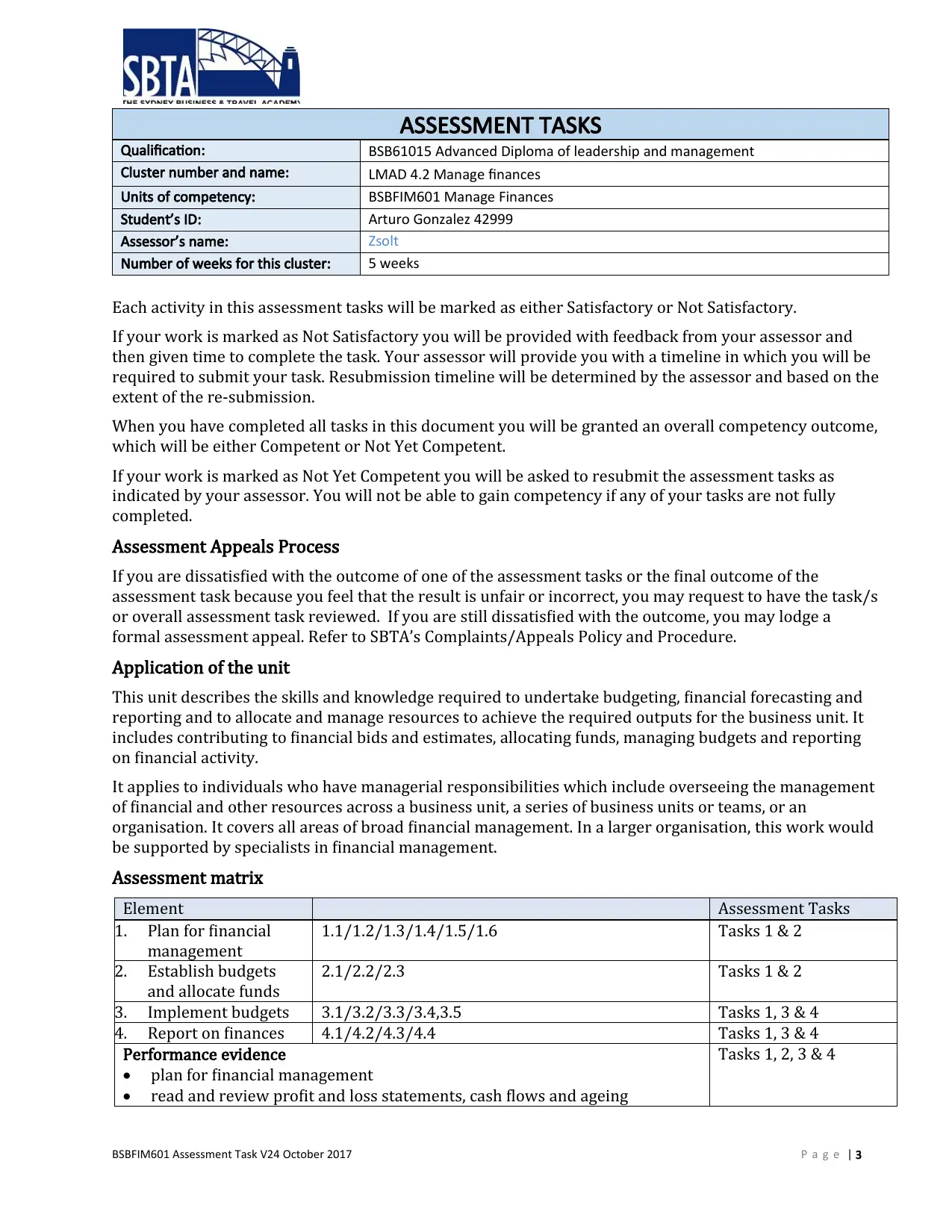
ASSESSMENT TASKS
Qualification: BSB61015 Advanced Diploma of leadership and management
Cluster number and name: LMAD 4.2 Manage finances
Units of competency: BSBFIM601 Manage Finances
Student’s ID: Arturo Gonzalez 42999
Assessor’s name: Zsolt
Number of weeks for this cluster: 5 weeks
Each activity in this assessment tasks will be marked as either Satisfactory or Not Satisfactory.
If your work is marked as Not Satisfactory you will be provided with feedback from your assessor and
then given time to complete the task. Your assessor will provide you with a timeline in which you will be
required to submit your task. Resubmission timeline will be determined by the assessor and based on the
extent of the re-submission.
When you have completed all tasks in this document you will be granted an overall competency outcome,
which will be either Competent or Not Yet Competent.
If your work is marked as Not Yet Competent you will be asked to resubmit the assessment tasks as
indicated by your assessor. You will not be able to gain competency if any of your tasks are not fully
completed.
Assessment Appeals Process
If you are dissatisfied with the outcome of one of the assessment tasks or the final outcome of the
assessment task because you feel that the result is unfair or incorrect, you may request to have the task/s
or overall assessment task reviewed. If you are still dissatisfied with the outcome, you may lodge a
formal assessment appeal. Refer to SBTA’s Complaints/Appeals Policy and Procedure.
Application of the unit
This unit describes the skills and knowledge required to undertake budgeting, financial forecasting and
reporting and to allocate and manage resources to achieve the required outputs for the business unit. It
includes contributing to financial bids and estimates, allocating funds, managing budgets and reporting
on financial activity.
It applies to individuals who have managerial responsibilities which include overseeing the management
of financial and other resources across a business unit, a series of business units or teams, or an
organisation. It covers all areas of broad financial management. In a larger organisation, this work would
be supported by specialists in financial management.
Assessment matrix
Element Assessment Tasks
1. Plan for financial
management
1.1/1.2/1.3/1.4/1.5/1.6 Tasks 1 & 2
2. Establish budgets
and allocate funds
2.1/2.2/2.3 Tasks 1 & 2
3. Implement budgets 3.1/3.2/3.3/3.4,3.5 Tasks 1, 3 & 4
4. Report on finances 4.1/4.2/4.3/4.4 Tasks 1, 3 & 4
Performance evidence
plan for financial management
read and review profit and loss statements, cash flows and ageing
Tasks 1, 2, 3 & 4
BSBFIM601 Assessment Task V24 October 2017 P a g e | 3
Qualification: BSB61015 Advanced Diploma of leadership and management
Cluster number and name: LMAD 4.2 Manage finances
Units of competency: BSBFIM601 Manage Finances
Student’s ID: Arturo Gonzalez 42999
Assessor’s name: Zsolt
Number of weeks for this cluster: 5 weeks
Each activity in this assessment tasks will be marked as either Satisfactory or Not Satisfactory.
If your work is marked as Not Satisfactory you will be provided with feedback from your assessor and
then given time to complete the task. Your assessor will provide you with a timeline in which you will be
required to submit your task. Resubmission timeline will be determined by the assessor and based on the
extent of the re-submission.
When you have completed all tasks in this document you will be granted an overall competency outcome,
which will be either Competent or Not Yet Competent.
If your work is marked as Not Yet Competent you will be asked to resubmit the assessment tasks as
indicated by your assessor. You will not be able to gain competency if any of your tasks are not fully
completed.
Assessment Appeals Process
If you are dissatisfied with the outcome of one of the assessment tasks or the final outcome of the
assessment task because you feel that the result is unfair or incorrect, you may request to have the task/s
or overall assessment task reviewed. If you are still dissatisfied with the outcome, you may lodge a
formal assessment appeal. Refer to SBTA’s Complaints/Appeals Policy and Procedure.
Application of the unit
This unit describes the skills and knowledge required to undertake budgeting, financial forecasting and
reporting and to allocate and manage resources to achieve the required outputs for the business unit. It
includes contributing to financial bids and estimates, allocating funds, managing budgets and reporting
on financial activity.
It applies to individuals who have managerial responsibilities which include overseeing the management
of financial and other resources across a business unit, a series of business units or teams, or an
organisation. It covers all areas of broad financial management. In a larger organisation, this work would
be supported by specialists in financial management.
Assessment matrix
Element Assessment Tasks
1. Plan for financial
management
1.1/1.2/1.3/1.4/1.5/1.6 Tasks 1 & 2
2. Establish budgets
and allocate funds
2.1/2.2/2.3 Tasks 1 & 2
3. Implement budgets 3.1/3.2/3.3/3.4,3.5 Tasks 1, 3 & 4
4. Report on finances 4.1/4.2/4.3/4.4 Tasks 1, 3 & 4
Performance evidence
plan for financial management
read and review profit and loss statements, cash flows and ageing
Tasks 1, 2, 3 & 4
BSBFIM601 Assessment Task V24 October 2017 P a g e | 3
⊘ This is a preview!⊘
Do you want full access?
Subscribe today to unlock all pages.

Trusted by 1+ million students worldwide
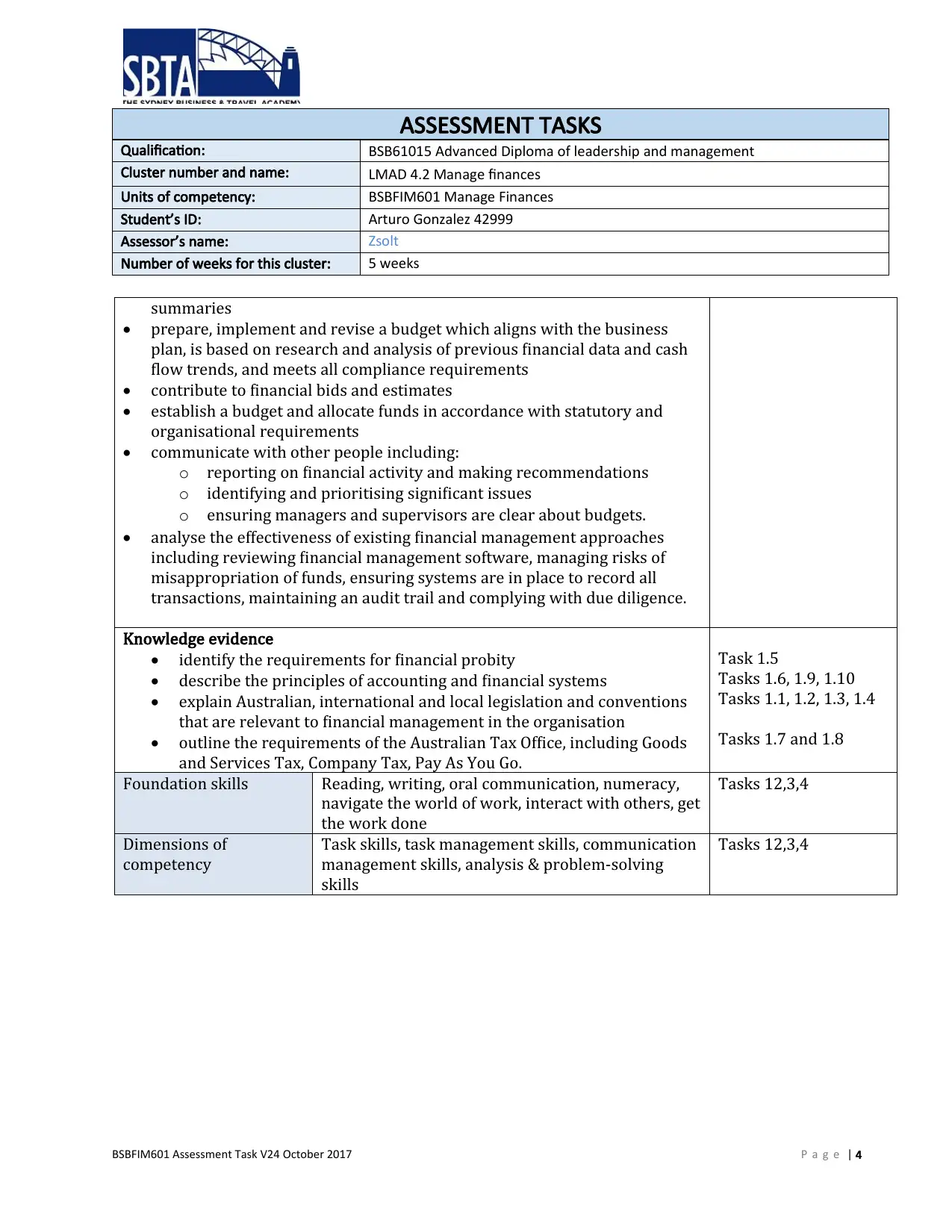
ASSESSMENT TASKS
Qualification: BSB61015 Advanced Diploma of leadership and management
Cluster number and name: LMAD 4.2 Manage finances
Units of competency: BSBFIM601 Manage Finances
Student’s ID: Arturo Gonzalez 42999
Assessor’s name: Zsolt
Number of weeks for this cluster: 5 weeks
summaries
prepare, implement and revise a budget which aligns with the business
plan, is based on research and analysis of previous financial data and cash
flow trends, and meets all compliance requirements
contribute to financial bids and estimates
establish a budget and allocate funds in accordance with statutory and
organisational requirements
communicate with other people including:
o reporting on financial activity and making recommendations
o identifying and prioritising significant issues
o ensuring managers and supervisors are clear about budgets.
analyse the effectiveness of existing financial management approaches
including reviewing financial management software, managing risks of
misappropriation of funds, ensuring systems are in place to record all
transactions, maintaining an audit trail and complying with due diligence.
Knowledge evidence
identify the requirements for financial probity
describe the principles of accounting and financial systems
explain Australian, international and local legislation and conventions
that are relevant to financial management in the organisation
outline the requirements of the Australian Tax Office, including Goods
and Services Tax, Company Tax, Pay As You Go.
Task 1.5
Tasks 1.6, 1.9, 1.10
Tasks 1.1, 1.2, 1.3, 1.4
Tasks 1.7 and 1.8
Foundation skills Reading, writing, oral communication, numeracy,
navigate the world of work, interact with others, get
the work done
Tasks 12,3,4
Dimensions of
competency
Task skills, task management skills, communication
management skills, analysis & problem-solving
skills
Tasks 12,3,4
BSBFIM601 Assessment Task V24 October 2017 P a g e | 4
Qualification: BSB61015 Advanced Diploma of leadership and management
Cluster number and name: LMAD 4.2 Manage finances
Units of competency: BSBFIM601 Manage Finances
Student’s ID: Arturo Gonzalez 42999
Assessor’s name: Zsolt
Number of weeks for this cluster: 5 weeks
summaries
prepare, implement and revise a budget which aligns with the business
plan, is based on research and analysis of previous financial data and cash
flow trends, and meets all compliance requirements
contribute to financial bids and estimates
establish a budget and allocate funds in accordance with statutory and
organisational requirements
communicate with other people including:
o reporting on financial activity and making recommendations
o identifying and prioritising significant issues
o ensuring managers and supervisors are clear about budgets.
analyse the effectiveness of existing financial management approaches
including reviewing financial management software, managing risks of
misappropriation of funds, ensuring systems are in place to record all
transactions, maintaining an audit trail and complying with due diligence.
Knowledge evidence
identify the requirements for financial probity
describe the principles of accounting and financial systems
explain Australian, international and local legislation and conventions
that are relevant to financial management in the organisation
outline the requirements of the Australian Tax Office, including Goods
and Services Tax, Company Tax, Pay As You Go.
Task 1.5
Tasks 1.6, 1.9, 1.10
Tasks 1.1, 1.2, 1.3, 1.4
Tasks 1.7 and 1.8
Foundation skills Reading, writing, oral communication, numeracy,
navigate the world of work, interact with others, get
the work done
Tasks 12,3,4
Dimensions of
competency
Task skills, task management skills, communication
management skills, analysis & problem-solving
skills
Tasks 12,3,4
BSBFIM601 Assessment Task V24 October 2017 P a g e | 4
Paraphrase This Document
Need a fresh take? Get an instant paraphrase of this document with our AI Paraphraser
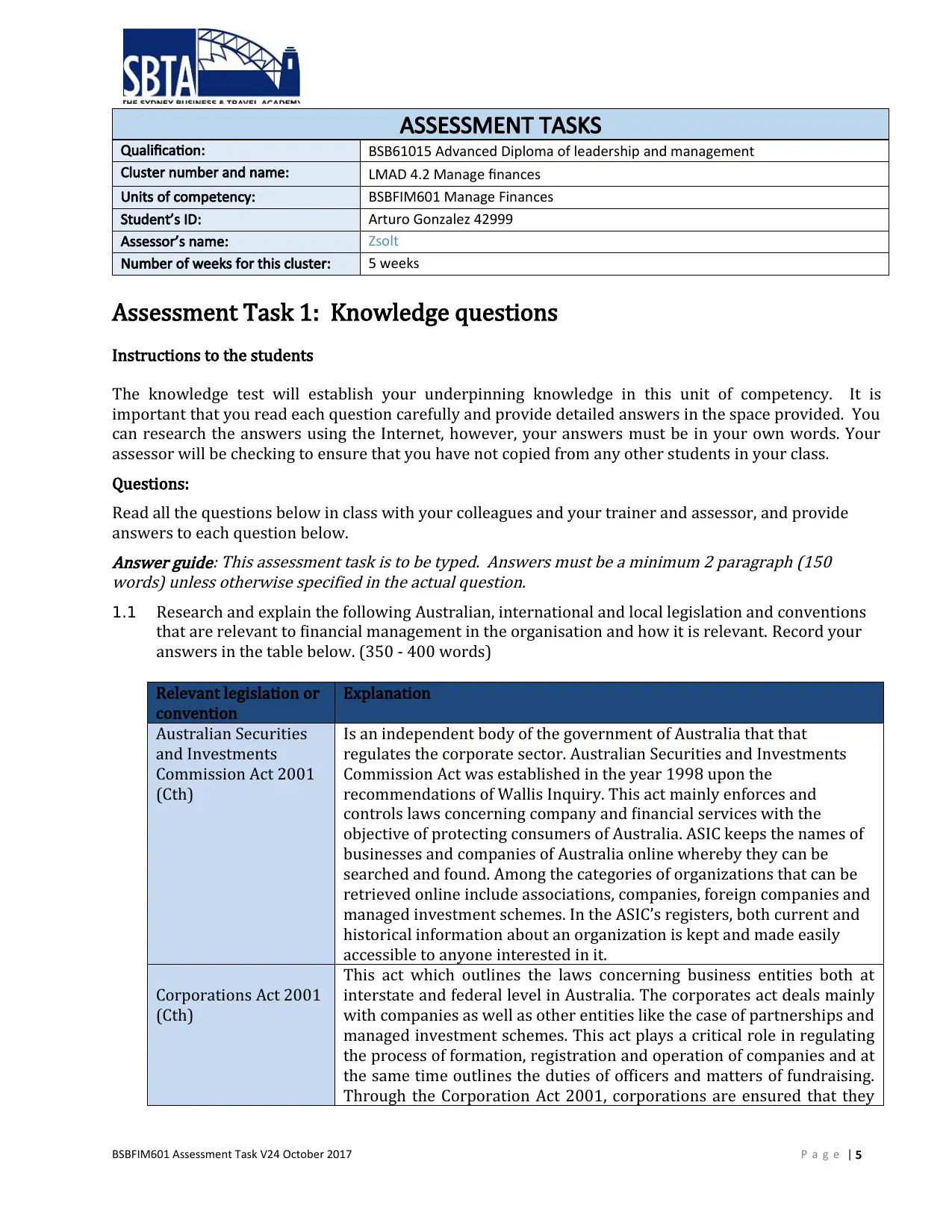
ASSESSMENT TASKS
Qualification: BSB61015 Advanced Diploma of leadership and management
Cluster number and name: LMAD 4.2 Manage finances
Units of competency: BSBFIM601 Manage Finances
Student’s ID: Arturo Gonzalez 42999
Assessor’s name: Zsolt
Number of weeks for this cluster: 5 weeks
Assessment Task 1: Knowledge questions
Instructions to the students
The knowledge test will establish your underpinning knowledge in this unit of competency. It is
important that you read each question carefully and provide detailed answers in the space provided. You
can research the answers using the Internet, however, your answers must be in your own words. Your
assessor will be checking to ensure that you have not copied from any other students in your class.
Questions:
Read all the questions below in class with your colleagues and your trainer and assessor, and provide
answers to each question below.Answer guide: This assessment task is to be typed. Answers must be a minimum 2 paragraph (150
words) unless otherwise specified in the actual question.
1.1 Research and explain the following Australian, international and local legislation and conventions
that are relevant to financial management in the organisation and how it is relevant. Record your
answers in the table below. (350 - 400 words)
Relevant legislation or
convention
Explanation
Australian Securities
and Investments
Commission Act 2001
(Cth)
Is an independent body of the government of Australia that that
regulates the corporate sector. Australian Securities and Investments
Commission Act was established in the year 1998 upon the
recommendations of Wallis Inquiry. This act mainly enforces and
controls laws concerning company and financial services with the
objective of protecting consumers of Australia. ASIC keeps the names of
businesses and companies of Australia online whereby they can be
searched and found. Among the categories of organizations that can be
retrieved online include associations, companies, foreign companies and
managed investment schemes. In the ASIC’s registers, both current and
historical information about an organization is kept and made easily
accessible to anyone interested in it.
Corporations Act 2001
(Cth)
This act which outlines the laws concerning business entities both at
interstate and federal level in Australia. The corporates act deals mainly
with companies as well as other entities like the case of partnerships and
managed investment schemes. This act plays a critical role in regulating
the process of formation, registration and operation of companies and at
the same time outlines the duties of officers and matters of fundraising.
Through the Corporation Act 2001, corporations are ensured that they
BSBFIM601 Assessment Task V24 October 2017 P a g e | 5
Qualification: BSB61015 Advanced Diploma of leadership and management
Cluster number and name: LMAD 4.2 Manage finances
Units of competency: BSBFIM601 Manage Finances
Student’s ID: Arturo Gonzalez 42999
Assessor’s name: Zsolt
Number of weeks for this cluster: 5 weeks
Assessment Task 1: Knowledge questions
Instructions to the students
The knowledge test will establish your underpinning knowledge in this unit of competency. It is
important that you read each question carefully and provide detailed answers in the space provided. You
can research the answers using the Internet, however, your answers must be in your own words. Your
assessor will be checking to ensure that you have not copied from any other students in your class.
Questions:
Read all the questions below in class with your colleagues and your trainer and assessor, and provide
answers to each question below.Answer guide: This assessment task is to be typed. Answers must be a minimum 2 paragraph (150
words) unless otherwise specified in the actual question.
1.1 Research and explain the following Australian, international and local legislation and conventions
that are relevant to financial management in the organisation and how it is relevant. Record your
answers in the table below. (350 - 400 words)
Relevant legislation or
convention
Explanation
Australian Securities
and Investments
Commission Act 2001
(Cth)
Is an independent body of the government of Australia that that
regulates the corporate sector. Australian Securities and Investments
Commission Act was established in the year 1998 upon the
recommendations of Wallis Inquiry. This act mainly enforces and
controls laws concerning company and financial services with the
objective of protecting consumers of Australia. ASIC keeps the names of
businesses and companies of Australia online whereby they can be
searched and found. Among the categories of organizations that can be
retrieved online include associations, companies, foreign companies and
managed investment schemes. In the ASIC’s registers, both current and
historical information about an organization is kept and made easily
accessible to anyone interested in it.
Corporations Act 2001
(Cth)
This act which outlines the laws concerning business entities both at
interstate and federal level in Australia. The corporates act deals mainly
with companies as well as other entities like the case of partnerships and
managed investment schemes. This act plays a critical role in regulating
the process of formation, registration and operation of companies and at
the same time outlines the duties of officers and matters of fundraising.
Through the Corporation Act 2001, corporations are ensured that they
BSBFIM601 Assessment Task V24 October 2017 P a g e | 5
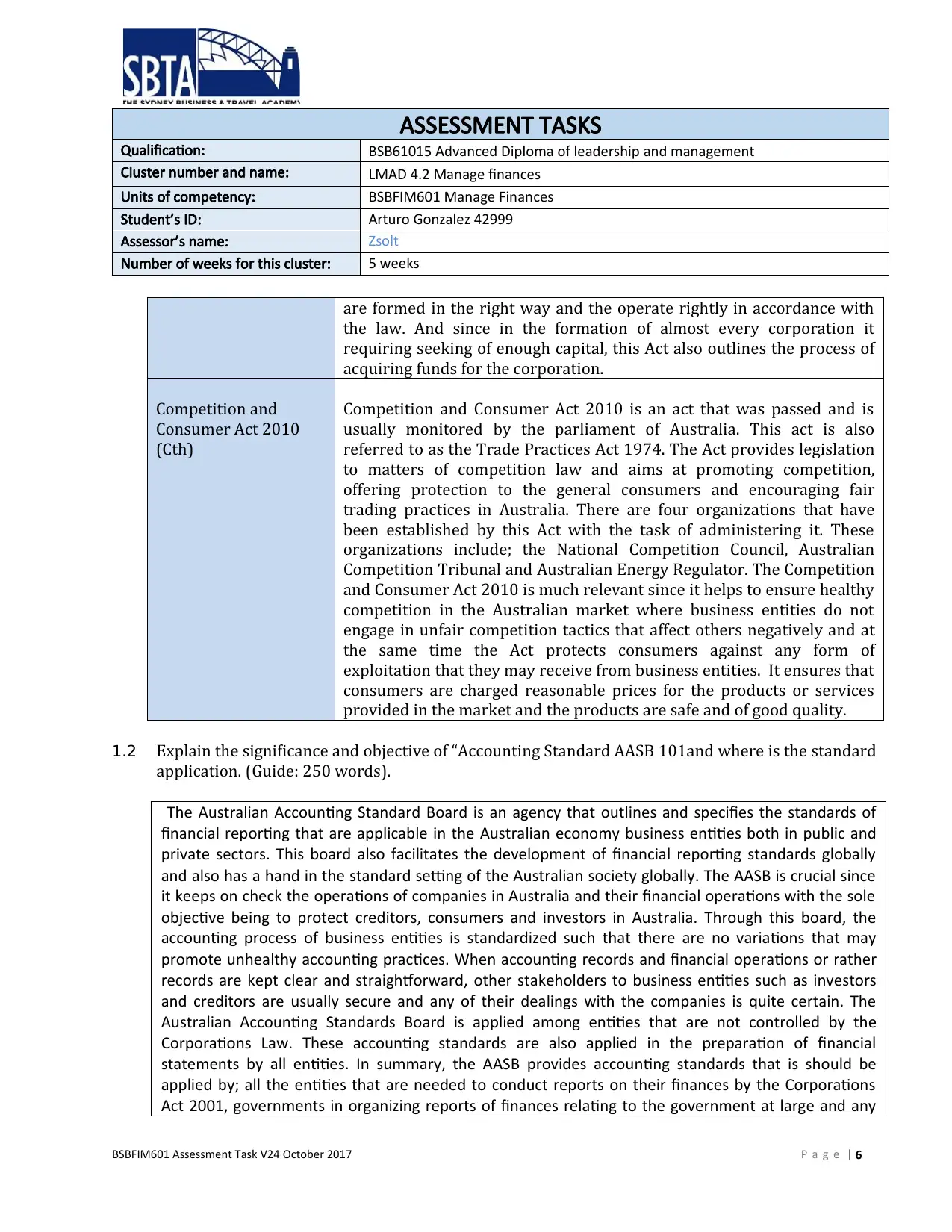
ASSESSMENT TASKS
Qualification: BSB61015 Advanced Diploma of leadership and management
Cluster number and name: LMAD 4.2 Manage finances
Units of competency: BSBFIM601 Manage Finances
Student’s ID: Arturo Gonzalez 42999
Assessor’s name: Zsolt
Number of weeks for this cluster: 5 weeks
are formed in the right way and the operate rightly in accordance with
the law. And since in the formation of almost every corporation it
requiring seeking of enough capital, this Act also outlines the process of
acquiring funds for the corporation.
Competition and
Consumer Act 2010
(Cth)
Competition and Consumer Act 2010 is an act that was passed and is
usually monitored by the parliament of Australia. This act is also
referred to as the Trade Practices Act 1974. The Act provides legislation
to matters of competition law and aims at promoting competition,
offering protection to the general consumers and encouraging fair
trading practices in Australia. There are four organizations that have
been established by this Act with the task of administering it. These
organizations include; the National Competition Council, Australian
Competition Tribunal and Australian Energy Regulator. The Competition
and Consumer Act 2010 is much relevant since it helps to ensure healthy
competition in the Australian market where business entities do not
engage in unfair competition tactics that affect others negatively and at
the same time the Act protects consumers against any form of
exploitation that they may receive from business entities. It ensures that
consumers are charged reasonable prices for the products or services
provided in the market and the products are safe and of good quality.
1.2 Explain the significance and objective of “Accounting Standard AASB 101and where is the standard
application. (Guide: 250 words).
The Australian Accounting Standard Board is an agency that outlines and specifies the standards of
financial reporting that are applicable in the Australian economy business entities both in public and
private sectors. This board also facilitates the development of financial reporting standards globally
and also has a hand in the standard setting of the Australian society globally. The AASB is crucial since
it keeps on check the operations of companies in Australia and their financial operations with the sole
objective being to protect creditors, consumers and investors in Australia. Through this board, the
accounting process of business entities is standardized such that there are no variations that may
promote unhealthy accounting practices. When accounting records and financial operations or rather
records are kept clear and straightforward, other stakeholders to business entities such as investors
and creditors are usually secure and any of their dealings with the companies is quite certain. The
Australian Accounting Standards Board is applied among entities that are not controlled by the
Corporations Law. These accounting standards are also applied in the preparation of financial
statements by all entities. In summary, the AASB provides accounting standards that is should be
applied by; all the entities that are needed to conduct reports on their finances by the Corporations
Act 2001, governments in organizing reports of finances relating to the government at large and any
BSBFIM601 Assessment Task V24 October 2017 P a g e | 6
Qualification: BSB61015 Advanced Diploma of leadership and management
Cluster number and name: LMAD 4.2 Manage finances
Units of competency: BSBFIM601 Manage Finances
Student’s ID: Arturo Gonzalez 42999
Assessor’s name: Zsolt
Number of weeks for this cluster: 5 weeks
are formed in the right way and the operate rightly in accordance with
the law. And since in the formation of almost every corporation it
requiring seeking of enough capital, this Act also outlines the process of
acquiring funds for the corporation.
Competition and
Consumer Act 2010
(Cth)
Competition and Consumer Act 2010 is an act that was passed and is
usually monitored by the parliament of Australia. This act is also
referred to as the Trade Practices Act 1974. The Act provides legislation
to matters of competition law and aims at promoting competition,
offering protection to the general consumers and encouraging fair
trading practices in Australia. There are four organizations that have
been established by this Act with the task of administering it. These
organizations include; the National Competition Council, Australian
Competition Tribunal and Australian Energy Regulator. The Competition
and Consumer Act 2010 is much relevant since it helps to ensure healthy
competition in the Australian market where business entities do not
engage in unfair competition tactics that affect others negatively and at
the same time the Act protects consumers against any form of
exploitation that they may receive from business entities. It ensures that
consumers are charged reasonable prices for the products or services
provided in the market and the products are safe and of good quality.
1.2 Explain the significance and objective of “Accounting Standard AASB 101and where is the standard
application. (Guide: 250 words).
The Australian Accounting Standard Board is an agency that outlines and specifies the standards of
financial reporting that are applicable in the Australian economy business entities both in public and
private sectors. This board also facilitates the development of financial reporting standards globally
and also has a hand in the standard setting of the Australian society globally. The AASB is crucial since
it keeps on check the operations of companies in Australia and their financial operations with the sole
objective being to protect creditors, consumers and investors in Australia. Through this board, the
accounting process of business entities is standardized such that there are no variations that may
promote unhealthy accounting practices. When accounting records and financial operations or rather
records are kept clear and straightforward, other stakeholders to business entities such as investors
and creditors are usually secure and any of their dealings with the companies is quite certain. The
Australian Accounting Standards Board is applied among entities that are not controlled by the
Corporations Law. These accounting standards are also applied in the preparation of financial
statements by all entities. In summary, the AASB provides accounting standards that is should be
applied by; all the entities that are needed to conduct reports on their finances by the Corporations
Act 2001, governments in organizing reports of finances relating to the government at large and any
BSBFIM601 Assessment Task V24 October 2017 P a g e | 6
⊘ This is a preview!⊘
Do you want full access?
Subscribe today to unlock all pages.

Trusted by 1+ million students worldwide
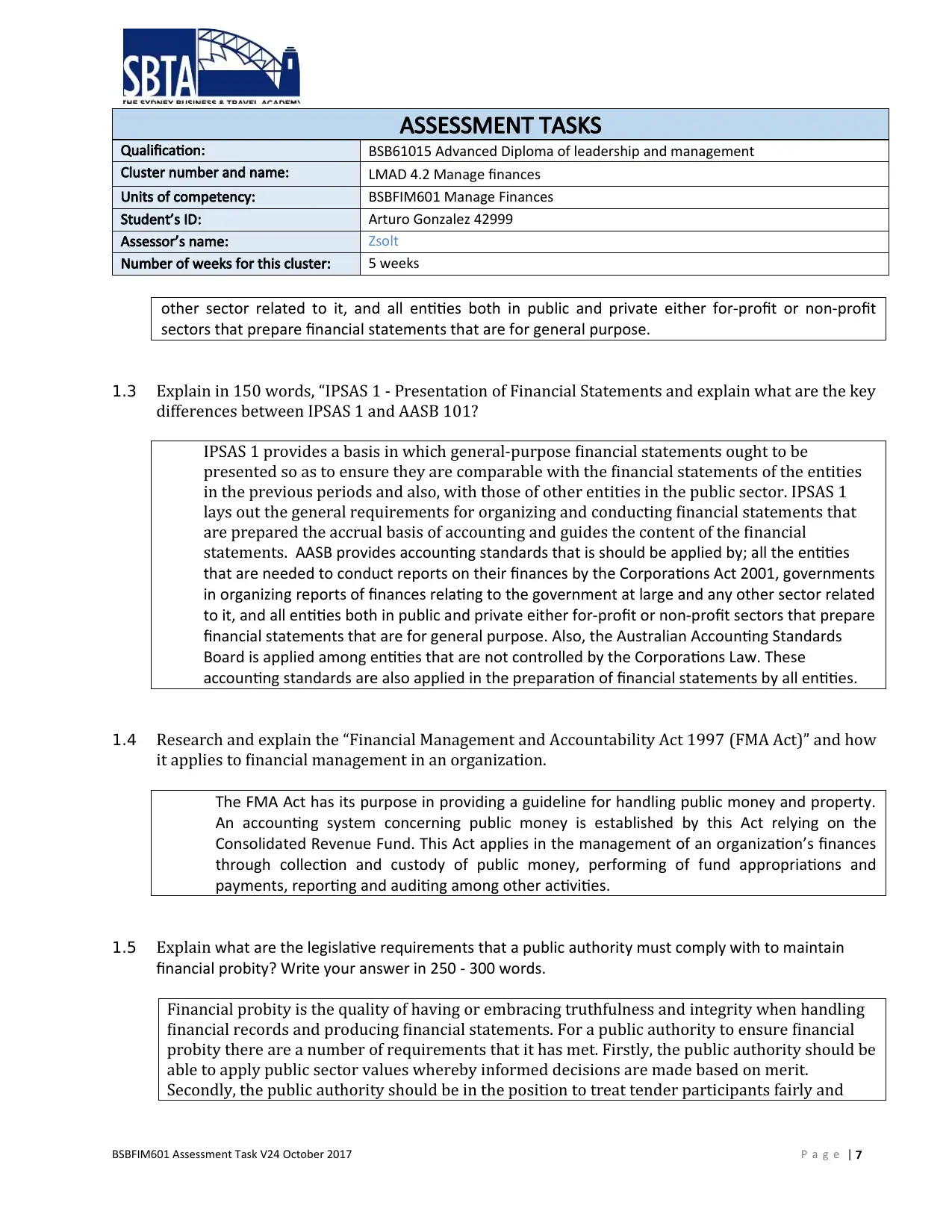
ASSESSMENT TASKS
Qualification: BSB61015 Advanced Diploma of leadership and management
Cluster number and name: LMAD 4.2 Manage finances
Units of competency: BSBFIM601 Manage Finances
Student’s ID: Arturo Gonzalez 42999
Assessor’s name: Zsolt
Number of weeks for this cluster: 5 weeks
other sector related to it, and all entities both in public and private either for-profit or non-profit
sectors that prepare financial statements that are for general purpose.
1.3 Explain in 150 words, “IPSAS 1 - Presentation of Financial Statements and explain what are the key
differences between IPSAS 1 and AASB 101?
IPSAS 1 provides a basis in which general-purpose financial statements ought to be
presented so as to ensure they are comparable with the financial statements of the entities
in the previous periods and also, with those of other entities in the public sector. IPSAS 1
lays out the general requirements for organizing and conducting financial statements that
are prepared the accrual basis of accounting and guides the content of the financial
statements. AASB provides accounting standards that is should be applied by; all the entities
that are needed to conduct reports on their finances by the Corporations Act 2001, governments
in organizing reports of finances relating to the government at large and any other sector related
to it, and all entities both in public and private either for-profit or non-profit sectors that prepare
financial statements that are for general purpose. Also, the Australian Accounting Standards
Board is applied among entities that are not controlled by the Corporations Law. These
accounting standards are also applied in the preparation of financial statements by all entities.
1.4 Research and explain the “Financial Management and Accountability Act 1997 (FMA Act)” and how
it applies to financial management in an organization.
The FMA Act has its purpose in providing a guideline for handling public money and property.
An accounting system concerning public money is established by this Act relying on the
Consolidated Revenue Fund. This Act applies in the management of an organization’s finances
through collection and custody of public money, performing of fund appropriations and
payments, reporting and auditing among other activities.
1.5 Explain what are the legislative requirements that a public authority must comply with to maintain
financial probity? Write your answer in 250 - 300 words.
Financial probity is the quality of having or embracing truthfulness and integrity when handling
financial records and producing financial statements. For a public authority to ensure financial
probity there are a number of requirements that it has met. Firstly, the public authority should be
able to apply public sector values whereby informed decisions are made based on merit.
Secondly, the public authority should be in the position to treat tender participants fairly and
BSBFIM601 Assessment Task V24 October 2017 P a g e | 7
Qualification: BSB61015 Advanced Diploma of leadership and management
Cluster number and name: LMAD 4.2 Manage finances
Units of competency: BSBFIM601 Manage Finances
Student’s ID: Arturo Gonzalez 42999
Assessor’s name: Zsolt
Number of weeks for this cluster: 5 weeks
other sector related to it, and all entities both in public and private either for-profit or non-profit
sectors that prepare financial statements that are for general purpose.
1.3 Explain in 150 words, “IPSAS 1 - Presentation of Financial Statements and explain what are the key
differences between IPSAS 1 and AASB 101?
IPSAS 1 provides a basis in which general-purpose financial statements ought to be
presented so as to ensure they are comparable with the financial statements of the entities
in the previous periods and also, with those of other entities in the public sector. IPSAS 1
lays out the general requirements for organizing and conducting financial statements that
are prepared the accrual basis of accounting and guides the content of the financial
statements. AASB provides accounting standards that is should be applied by; all the entities
that are needed to conduct reports on their finances by the Corporations Act 2001, governments
in organizing reports of finances relating to the government at large and any other sector related
to it, and all entities both in public and private either for-profit or non-profit sectors that prepare
financial statements that are for general purpose. Also, the Australian Accounting Standards
Board is applied among entities that are not controlled by the Corporations Law. These
accounting standards are also applied in the preparation of financial statements by all entities.
1.4 Research and explain the “Financial Management and Accountability Act 1997 (FMA Act)” and how
it applies to financial management in an organization.
The FMA Act has its purpose in providing a guideline for handling public money and property.
An accounting system concerning public money is established by this Act relying on the
Consolidated Revenue Fund. This Act applies in the management of an organization’s finances
through collection and custody of public money, performing of fund appropriations and
payments, reporting and auditing among other activities.
1.5 Explain what are the legislative requirements that a public authority must comply with to maintain
financial probity? Write your answer in 250 - 300 words.
Financial probity is the quality of having or embracing truthfulness and integrity when handling
financial records and producing financial statements. For a public authority to ensure financial
probity there are a number of requirements that it has met. Firstly, the public authority should be
able to apply public sector values whereby informed decisions are made based on merit.
Secondly, the public authority should be in the position to treat tender participants fairly and
BSBFIM601 Assessment Task V24 October 2017 P a g e | 7
Paraphrase This Document
Need a fresh take? Get an instant paraphrase of this document with our AI Paraphraser
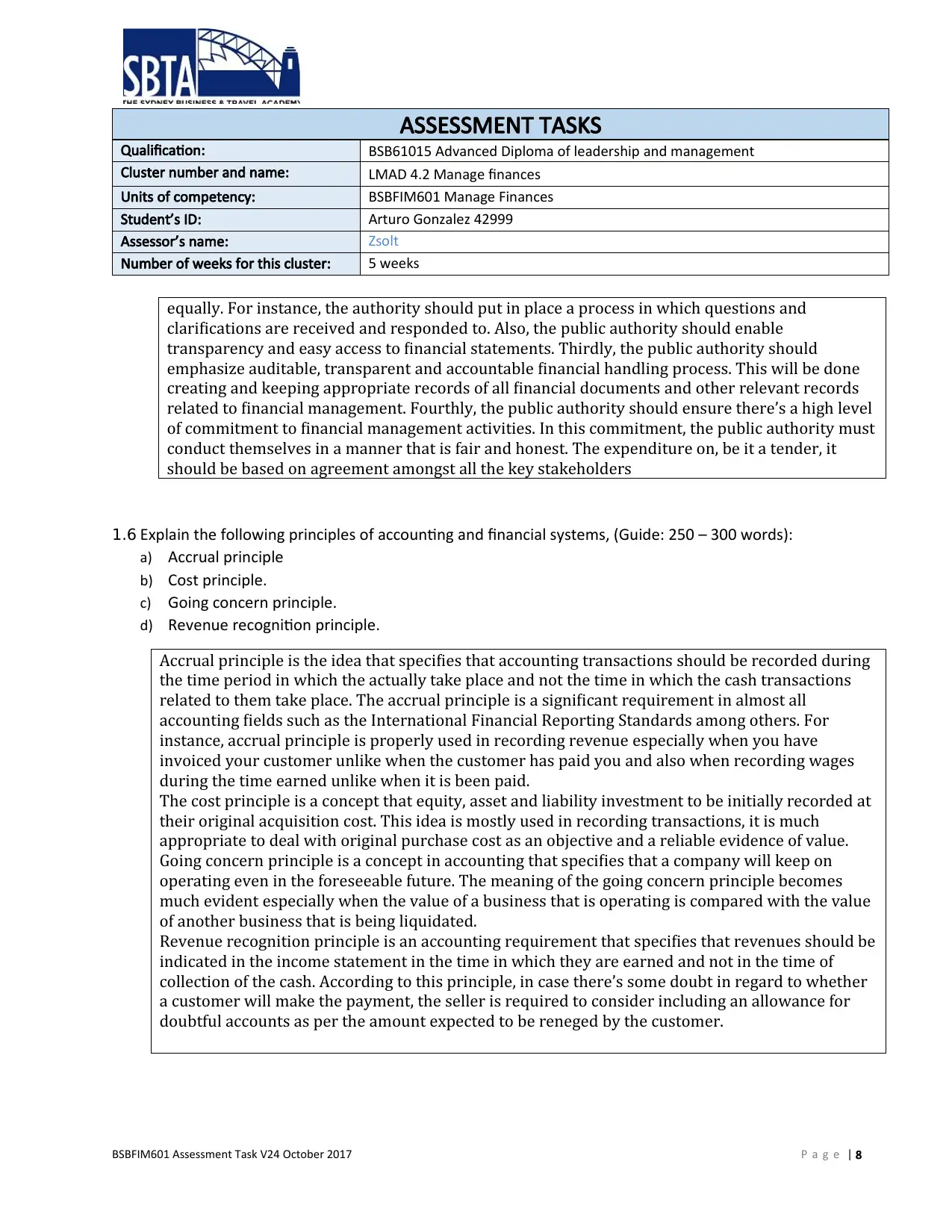
ASSESSMENT TASKS
Qualification: BSB61015 Advanced Diploma of leadership and management
Cluster number and name: LMAD 4.2 Manage finances
Units of competency: BSBFIM601 Manage Finances
Student’s ID: Arturo Gonzalez 42999
Assessor’s name: Zsolt
Number of weeks for this cluster: 5 weeks
equally. For instance, the authority should put in place a process in which questions and
clarifications are received and responded to. Also, the public authority should enable
transparency and easy access to financial statements. Thirdly, the public authority should
emphasize auditable, transparent and accountable financial handling process. This will be done
creating and keeping appropriate records of all financial documents and other relevant records
related to financial management. Fourthly, the public authority should ensure there’s a high level
of commitment to financial management activities. In this commitment, the public authority must
conduct themselves in a manner that is fair and honest. The expenditure on, be it a tender, it
should be based on agreement amongst all the key stakeholders
1.6 Explain the following principles of accounting and financial systems, (Guide: 250 – 300 words):
a) Accrual principle
b) Cost principle.
c) Going concern principle.
d) Revenue recognition principle.
Accrual principle is the idea that specifies that accounting transactions should be recorded during
the time period in which the actually take place and not the time in which the cash transactions
related to them take place. The accrual principle is a significant requirement in almost all
accounting fields such as the International Financial Reporting Standards among others. For
instance, accrual principle is properly used in recording revenue especially when you have
invoiced your customer unlike when the customer has paid you and also when recording wages
during the time earned unlike when it is been paid.
The cost principle is a concept that equity, asset and liability investment to be initially recorded at
their original acquisition cost. This idea is mostly used in recording transactions, it is much
appropriate to deal with original purchase cost as an objective and a reliable evidence of value.
Going concern principle is a concept in accounting that specifies that a company will keep on
operating even in the foreseeable future. The meaning of the going concern principle becomes
much evident especially when the value of a business that is operating is compared with the value
of another business that is being liquidated.
Revenue recognition principle is an accounting requirement that specifies that revenues should be
indicated in the income statement in the time in which they are earned and not in the time of
collection of the cash. According to this principle, in case there’s some doubt in regard to whether
a customer will make the payment, the seller is required to consider including an allowance for
doubtful accounts as per the amount expected to be reneged by the customer.
BSBFIM601 Assessment Task V24 October 2017 P a g e | 8
Qualification: BSB61015 Advanced Diploma of leadership and management
Cluster number and name: LMAD 4.2 Manage finances
Units of competency: BSBFIM601 Manage Finances
Student’s ID: Arturo Gonzalez 42999
Assessor’s name: Zsolt
Number of weeks for this cluster: 5 weeks
equally. For instance, the authority should put in place a process in which questions and
clarifications are received and responded to. Also, the public authority should enable
transparency and easy access to financial statements. Thirdly, the public authority should
emphasize auditable, transparent and accountable financial handling process. This will be done
creating and keeping appropriate records of all financial documents and other relevant records
related to financial management. Fourthly, the public authority should ensure there’s a high level
of commitment to financial management activities. In this commitment, the public authority must
conduct themselves in a manner that is fair and honest. The expenditure on, be it a tender, it
should be based on agreement amongst all the key stakeholders
1.6 Explain the following principles of accounting and financial systems, (Guide: 250 – 300 words):
a) Accrual principle
b) Cost principle.
c) Going concern principle.
d) Revenue recognition principle.
Accrual principle is the idea that specifies that accounting transactions should be recorded during
the time period in which the actually take place and not the time in which the cash transactions
related to them take place. The accrual principle is a significant requirement in almost all
accounting fields such as the International Financial Reporting Standards among others. For
instance, accrual principle is properly used in recording revenue especially when you have
invoiced your customer unlike when the customer has paid you and also when recording wages
during the time earned unlike when it is been paid.
The cost principle is a concept that equity, asset and liability investment to be initially recorded at
their original acquisition cost. This idea is mostly used in recording transactions, it is much
appropriate to deal with original purchase cost as an objective and a reliable evidence of value.
Going concern principle is a concept in accounting that specifies that a company will keep on
operating even in the foreseeable future. The meaning of the going concern principle becomes
much evident especially when the value of a business that is operating is compared with the value
of another business that is being liquidated.
Revenue recognition principle is an accounting requirement that specifies that revenues should be
indicated in the income statement in the time in which they are earned and not in the time of
collection of the cash. According to this principle, in case there’s some doubt in regard to whether
a customer will make the payment, the seller is required to consider including an allowance for
doubtful accounts as per the amount expected to be reneged by the customer.
BSBFIM601 Assessment Task V24 October 2017 P a g e | 8
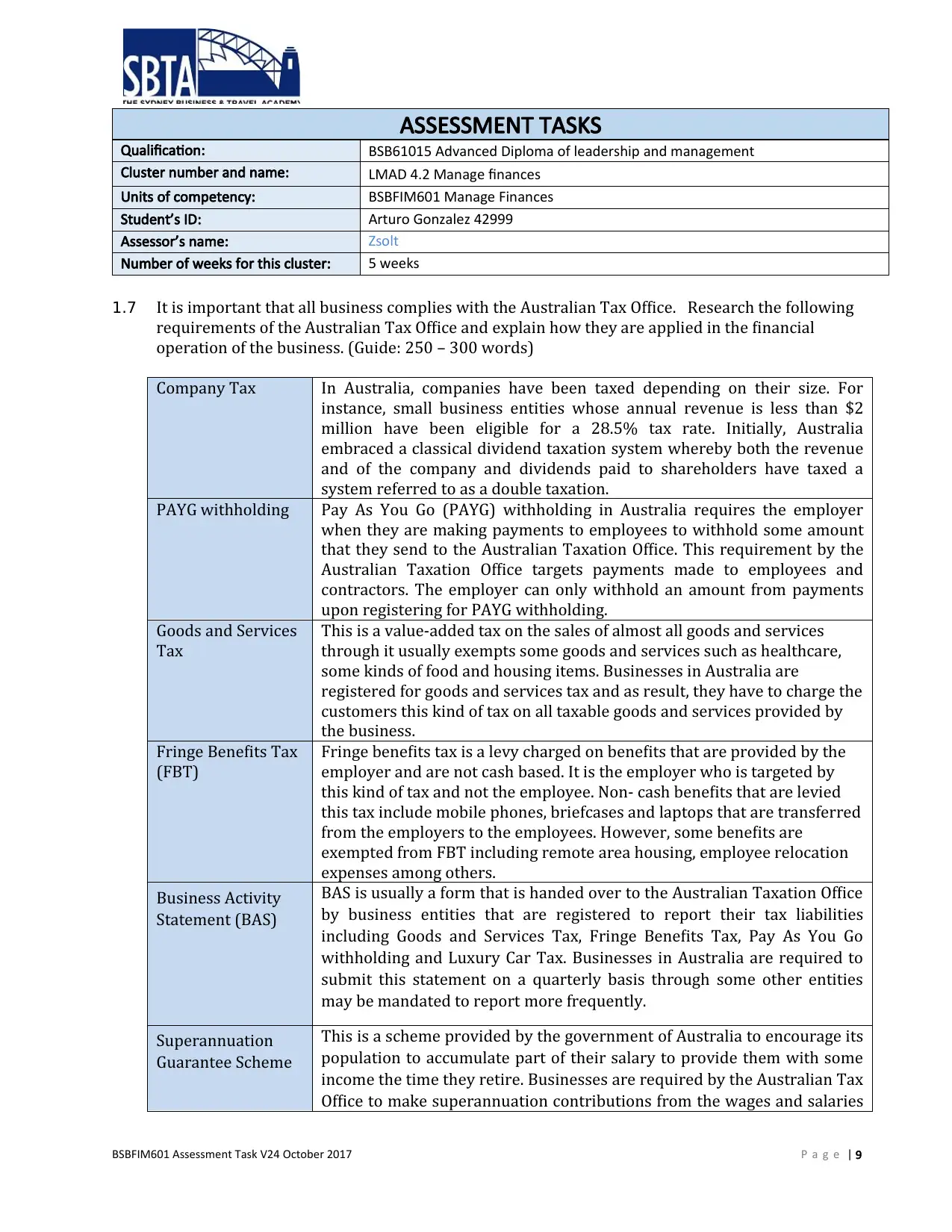
ASSESSMENT TASKS
Qualification: BSB61015 Advanced Diploma of leadership and management
Cluster number and name: LMAD 4.2 Manage finances
Units of competency: BSBFIM601 Manage Finances
Student’s ID: Arturo Gonzalez 42999
Assessor’s name: Zsolt
Number of weeks for this cluster: 5 weeks
1.7 It is important that all business complies with the Australian Tax Office. Research the following
requirements of the Australian Tax Office and explain how they are applied in the financial
operation of the business. (Guide: 250 – 300 words)
Company Tax In Australia, companies have been taxed depending on their size. For
instance, small business entities whose annual revenue is less than $2
million have been eligible for a 28.5% tax rate. Initially, Australia
embraced a classical dividend taxation system whereby both the revenue
and of the company and dividends paid to shareholders have taxed a
system referred to as a double taxation.
PAYG withholding Pay As You Go (PAYG) withholding in Australia requires the employer
when they are making payments to employees to withhold some amount
that they send to the Australian Taxation Office. This requirement by the
Australian Taxation Office targets payments made to employees and
contractors. The employer can only withhold an amount from payments
upon registering for PAYG withholding.
Goods and Services
Tax
This is a value-added tax on the sales of almost all goods and services
through it usually exempts some goods and services such as healthcare,
some kinds of food and housing items. Businesses in Australia are
registered for goods and services tax and as result, they have to charge the
customers this kind of tax on all taxable goods and services provided by
the business.
Fringe Benefits Tax
(FBT)
Fringe benefits tax is a levy charged on benefits that are provided by the
employer and are not cash based. It is the employer who is targeted by
this kind of tax and not the employee. Non- cash benefits that are levied
this tax include mobile phones, briefcases and laptops that are transferred
from the employers to the employees. However, some benefits are
exempted from FBT including remote area housing, employee relocation
expenses among others.
Business Activity
Statement (BAS)
BAS is usually a form that is handed over to the Australian Taxation Office
by business entities that are registered to report their tax liabilities
including Goods and Services Tax, Fringe Benefits Tax, Pay As You Go
withholding and Luxury Car Tax. Businesses in Australia are required to
submit this statement on a quarterly basis through some other entities
may be mandated to report more frequently.
Superannuation
Guarantee Scheme
This is a scheme provided by the government of Australia to encourage its
population to accumulate part of their salary to provide them with some
income the time they retire. Businesses are required by the Australian Tax
Office to make superannuation contributions from the wages and salaries
BSBFIM601 Assessment Task V24 October 2017 P a g e | 9
Qualification: BSB61015 Advanced Diploma of leadership and management
Cluster number and name: LMAD 4.2 Manage finances
Units of competency: BSBFIM601 Manage Finances
Student’s ID: Arturo Gonzalez 42999
Assessor’s name: Zsolt
Number of weeks for this cluster: 5 weeks
1.7 It is important that all business complies with the Australian Tax Office. Research the following
requirements of the Australian Tax Office and explain how they are applied in the financial
operation of the business. (Guide: 250 – 300 words)
Company Tax In Australia, companies have been taxed depending on their size. For
instance, small business entities whose annual revenue is less than $2
million have been eligible for a 28.5% tax rate. Initially, Australia
embraced a classical dividend taxation system whereby both the revenue
and of the company and dividends paid to shareholders have taxed a
system referred to as a double taxation.
PAYG withholding Pay As You Go (PAYG) withholding in Australia requires the employer
when they are making payments to employees to withhold some amount
that they send to the Australian Taxation Office. This requirement by the
Australian Taxation Office targets payments made to employees and
contractors. The employer can only withhold an amount from payments
upon registering for PAYG withholding.
Goods and Services
Tax
This is a value-added tax on the sales of almost all goods and services
through it usually exempts some goods and services such as healthcare,
some kinds of food and housing items. Businesses in Australia are
registered for goods and services tax and as result, they have to charge the
customers this kind of tax on all taxable goods and services provided by
the business.
Fringe Benefits Tax
(FBT)
Fringe benefits tax is a levy charged on benefits that are provided by the
employer and are not cash based. It is the employer who is targeted by
this kind of tax and not the employee. Non- cash benefits that are levied
this tax include mobile phones, briefcases and laptops that are transferred
from the employers to the employees. However, some benefits are
exempted from FBT including remote area housing, employee relocation
expenses among others.
Business Activity
Statement (BAS)
BAS is usually a form that is handed over to the Australian Taxation Office
by business entities that are registered to report their tax liabilities
including Goods and Services Tax, Fringe Benefits Tax, Pay As You Go
withholding and Luxury Car Tax. Businesses in Australia are required to
submit this statement on a quarterly basis through some other entities
may be mandated to report more frequently.
Superannuation
Guarantee Scheme
This is a scheme provided by the government of Australia to encourage its
population to accumulate part of their salary to provide them with some
income the time they retire. Businesses are required by the Australian Tax
Office to make superannuation contributions from the wages and salaries
BSBFIM601 Assessment Task V24 October 2017 P a g e | 9
⊘ This is a preview!⊘
Do you want full access?
Subscribe today to unlock all pages.

Trusted by 1+ million students worldwide
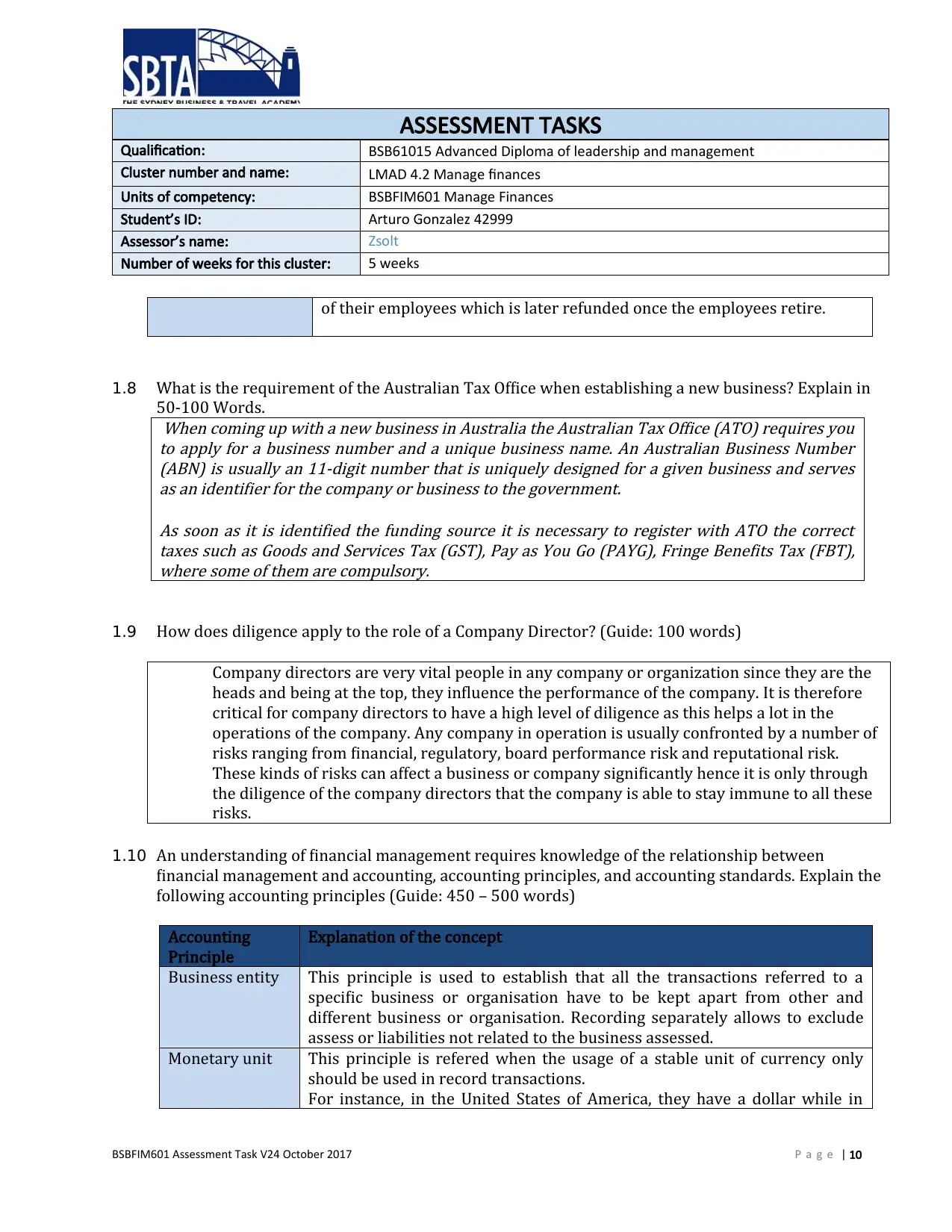
ASSESSMENT TASKS
Qualification: BSB61015 Advanced Diploma of leadership and management
Cluster number and name: LMAD 4.2 Manage finances
Units of competency: BSBFIM601 Manage Finances
Student’s ID: Arturo Gonzalez 42999
Assessor’s name: Zsolt
Number of weeks for this cluster: 5 weeks
of their employees which is later refunded once the employees retire.
1.8 What is the requirement of the Australian Tax Office when establishing a new business? Explain in
50-100 Words.
When coming up with a new business in Australia the Australian Tax Office (ATO) requires you
to apply for a business number and a unique business name. An Australian Business Number
(ABN) is usually an 11-digit number that is uniquely designed for a given business and serves
as an identifier for the company or business to the government.
As soon as it is identified the funding source it is necessary to register with ATO the correct
taxes such as Goods and Services Tax (GST), Pay as You Go (PAYG), Fringe Benefits Tax (FBT),
where some of them are compulsory.
1.9 How does diligence apply to the role of a Company Director? (Guide: 100 words)
Company directors are very vital people in any company or organization since they are the
heads and being at the top, they influence the performance of the company. It is therefore
critical for company directors to have a high level of diligence as this helps a lot in the
operations of the company. Any company in operation is usually confronted by a number of
risks ranging from financial, regulatory, board performance risk and reputational risk.
These kinds of risks can affect a business or company significantly hence it is only through
the diligence of the company directors that the company is able to stay immune to all these
risks.
1.10 An understanding of financial management requires knowledge of the relationship between
financial management and accounting, accounting principles, and accounting standards. Explain the
following accounting principles (Guide: 450 – 500 words)
Accounting
Principle
Explanation of the concept
Business entity This principle is used to establish that all the transactions referred to a
specific business or organisation have to be kept apart from other and
different business or organisation. Recording separately allows to exclude
assess or liabilities not related to the business assessed.
Monetary unit This principle is refered when the usage of a stable unit of currency only
should be used in record transactions.
For instance, in the United States of America, they have a dollar while in
BSBFIM601 Assessment Task V24 October 2017 P a g e | 10
Qualification: BSB61015 Advanced Diploma of leadership and management
Cluster number and name: LMAD 4.2 Manage finances
Units of competency: BSBFIM601 Manage Finances
Student’s ID: Arturo Gonzalez 42999
Assessor’s name: Zsolt
Number of weeks for this cluster: 5 weeks
of their employees which is later refunded once the employees retire.
1.8 What is the requirement of the Australian Tax Office when establishing a new business? Explain in
50-100 Words.
When coming up with a new business in Australia the Australian Tax Office (ATO) requires you
to apply for a business number and a unique business name. An Australian Business Number
(ABN) is usually an 11-digit number that is uniquely designed for a given business and serves
as an identifier for the company or business to the government.
As soon as it is identified the funding source it is necessary to register with ATO the correct
taxes such as Goods and Services Tax (GST), Pay as You Go (PAYG), Fringe Benefits Tax (FBT),
where some of them are compulsory.
1.9 How does diligence apply to the role of a Company Director? (Guide: 100 words)
Company directors are very vital people in any company or organization since they are the
heads and being at the top, they influence the performance of the company. It is therefore
critical for company directors to have a high level of diligence as this helps a lot in the
operations of the company. Any company in operation is usually confronted by a number of
risks ranging from financial, regulatory, board performance risk and reputational risk.
These kinds of risks can affect a business or company significantly hence it is only through
the diligence of the company directors that the company is able to stay immune to all these
risks.
1.10 An understanding of financial management requires knowledge of the relationship between
financial management and accounting, accounting principles, and accounting standards. Explain the
following accounting principles (Guide: 450 – 500 words)
Accounting
Principle
Explanation of the concept
Business entity This principle is used to establish that all the transactions referred to a
specific business or organisation have to be kept apart from other and
different business or organisation. Recording separately allows to exclude
assess or liabilities not related to the business assessed.
Monetary unit This principle is refered when the usage of a stable unit of currency only
should be used in record transactions.
For instance, in the United States of America, they have a dollar while in
BSBFIM601 Assessment Task V24 October 2017 P a g e | 10
Paraphrase This Document
Need a fresh take? Get an instant paraphrase of this document with our AI Paraphraser
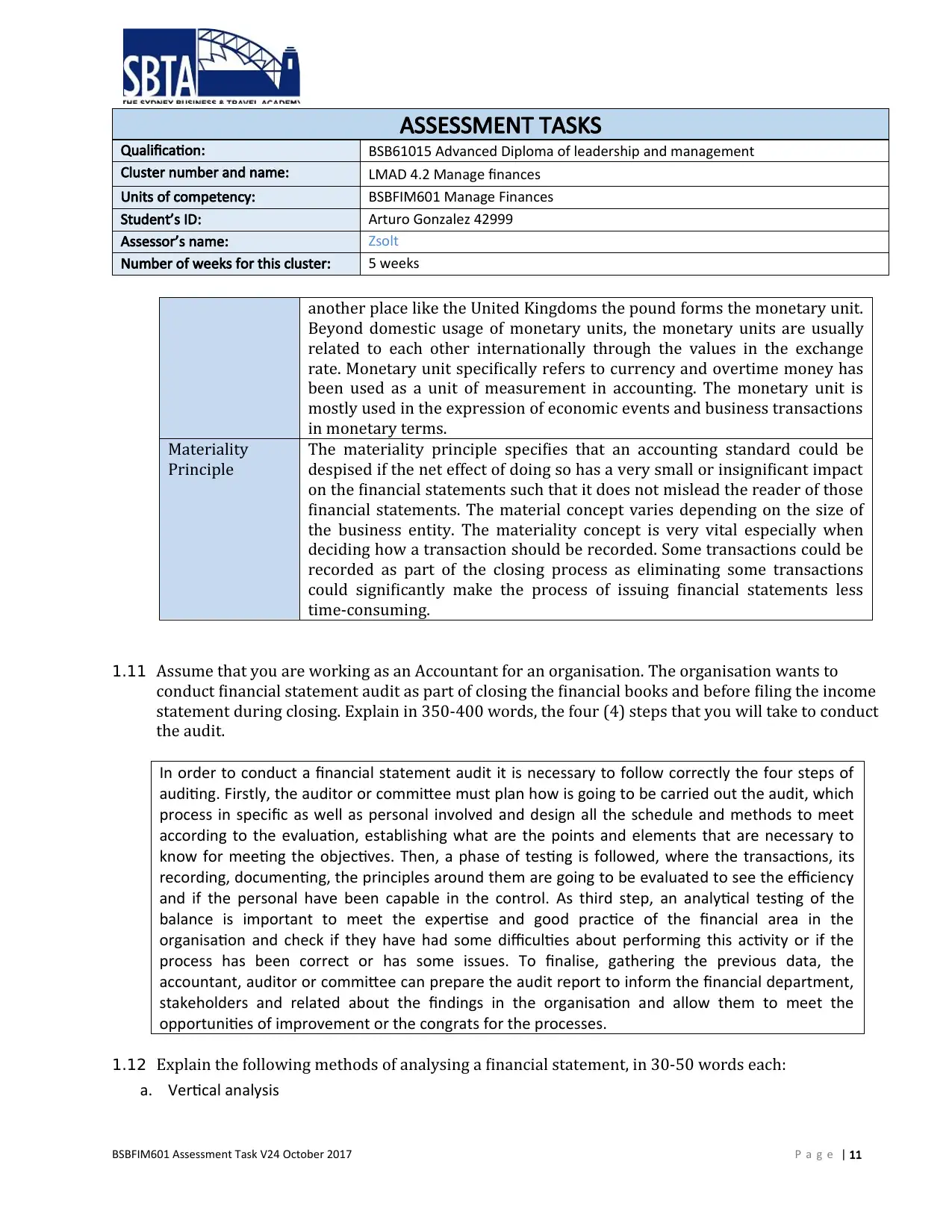
ASSESSMENT TASKS
Qualification: BSB61015 Advanced Diploma of leadership and management
Cluster number and name: LMAD 4.2 Manage finances
Units of competency: BSBFIM601 Manage Finances
Student’s ID: Arturo Gonzalez 42999
Assessor’s name: Zsolt
Number of weeks for this cluster: 5 weeks
another place like the United Kingdoms the pound forms the monetary unit.
Beyond domestic usage of monetary units, the monetary units are usually
related to each other internationally through the values in the exchange
rate. Monetary unit specifically refers to currency and overtime money has
been used as a unit of measurement in accounting. The monetary unit is
mostly used in the expression of economic events and business transactions
in monetary terms.
Materiality
Principle
The materiality principle specifies that an accounting standard could be
despised if the net effect of doing so has a very small or insignificant impact
on the financial statements such that it does not mislead the reader of those
financial statements. The material concept varies depending on the size of
the business entity. The materiality concept is very vital especially when
deciding how a transaction should be recorded. Some transactions could be
recorded as part of the closing process as eliminating some transactions
could significantly make the process of issuing financial statements less
time-consuming.
1.11 Assume that you are working as an Accountant for an organisation. The organisation wants to
conduct financial statement audit as part of closing the financial books and before filing the income
statement during closing. Explain in 350-400 words, the four (4) steps that you will take to conduct
the audit.
In order to conduct a financial statement audit it is necessary to follow correctly the four steps of
auditing. Firstly, the auditor or committee must plan how is going to be carried out the audit, which
process in specific as well as personal involved and design all the schedule and methods to meet
according to the evaluation, establishing what are the points and elements that are necessary to
know for meeting the objectives. Then, a phase of testing is followed, where the transactions, its
recording, documenting, the principles around them are going to be evaluated to see the efficiency
and if the personal have been capable in the control. As third step, an analytical testing of the
balance is important to meet the expertise and good practice of the financial area in the
organisation and check if they have had some difficulties about performing this activity or if the
process has been correct or has some issues. To finalise, gathering the previous data, the
accountant, auditor or committee can prepare the audit report to inform the financial department,
stakeholders and related about the findings in the organisation and allow them to meet the
opportunities of improvement or the congrats for the processes.
1.12 Explain the following methods of analysing a financial statement, in 30-50 words each:
a. Vertical analysis
BSBFIM601 Assessment Task V24 October 2017 P a g e | 11
Qualification: BSB61015 Advanced Diploma of leadership and management
Cluster number and name: LMAD 4.2 Manage finances
Units of competency: BSBFIM601 Manage Finances
Student’s ID: Arturo Gonzalez 42999
Assessor’s name: Zsolt
Number of weeks for this cluster: 5 weeks
another place like the United Kingdoms the pound forms the monetary unit.
Beyond domestic usage of monetary units, the monetary units are usually
related to each other internationally through the values in the exchange
rate. Monetary unit specifically refers to currency and overtime money has
been used as a unit of measurement in accounting. The monetary unit is
mostly used in the expression of economic events and business transactions
in monetary terms.
Materiality
Principle
The materiality principle specifies that an accounting standard could be
despised if the net effect of doing so has a very small or insignificant impact
on the financial statements such that it does not mislead the reader of those
financial statements. The material concept varies depending on the size of
the business entity. The materiality concept is very vital especially when
deciding how a transaction should be recorded. Some transactions could be
recorded as part of the closing process as eliminating some transactions
could significantly make the process of issuing financial statements less
time-consuming.
1.11 Assume that you are working as an Accountant for an organisation. The organisation wants to
conduct financial statement audit as part of closing the financial books and before filing the income
statement during closing. Explain in 350-400 words, the four (4) steps that you will take to conduct
the audit.
In order to conduct a financial statement audit it is necessary to follow correctly the four steps of
auditing. Firstly, the auditor or committee must plan how is going to be carried out the audit, which
process in specific as well as personal involved and design all the schedule and methods to meet
according to the evaluation, establishing what are the points and elements that are necessary to
know for meeting the objectives. Then, a phase of testing is followed, where the transactions, its
recording, documenting, the principles around them are going to be evaluated to see the efficiency
and if the personal have been capable in the control. As third step, an analytical testing of the
balance is important to meet the expertise and good practice of the financial area in the
organisation and check if they have had some difficulties about performing this activity or if the
process has been correct or has some issues. To finalise, gathering the previous data, the
accountant, auditor or committee can prepare the audit report to inform the financial department,
stakeholders and related about the findings in the organisation and allow them to meet the
opportunities of improvement or the congrats for the processes.
1.12 Explain the following methods of analysing a financial statement, in 30-50 words each:
a. Vertical analysis
BSBFIM601 Assessment Task V24 October 2017 P a g e | 11
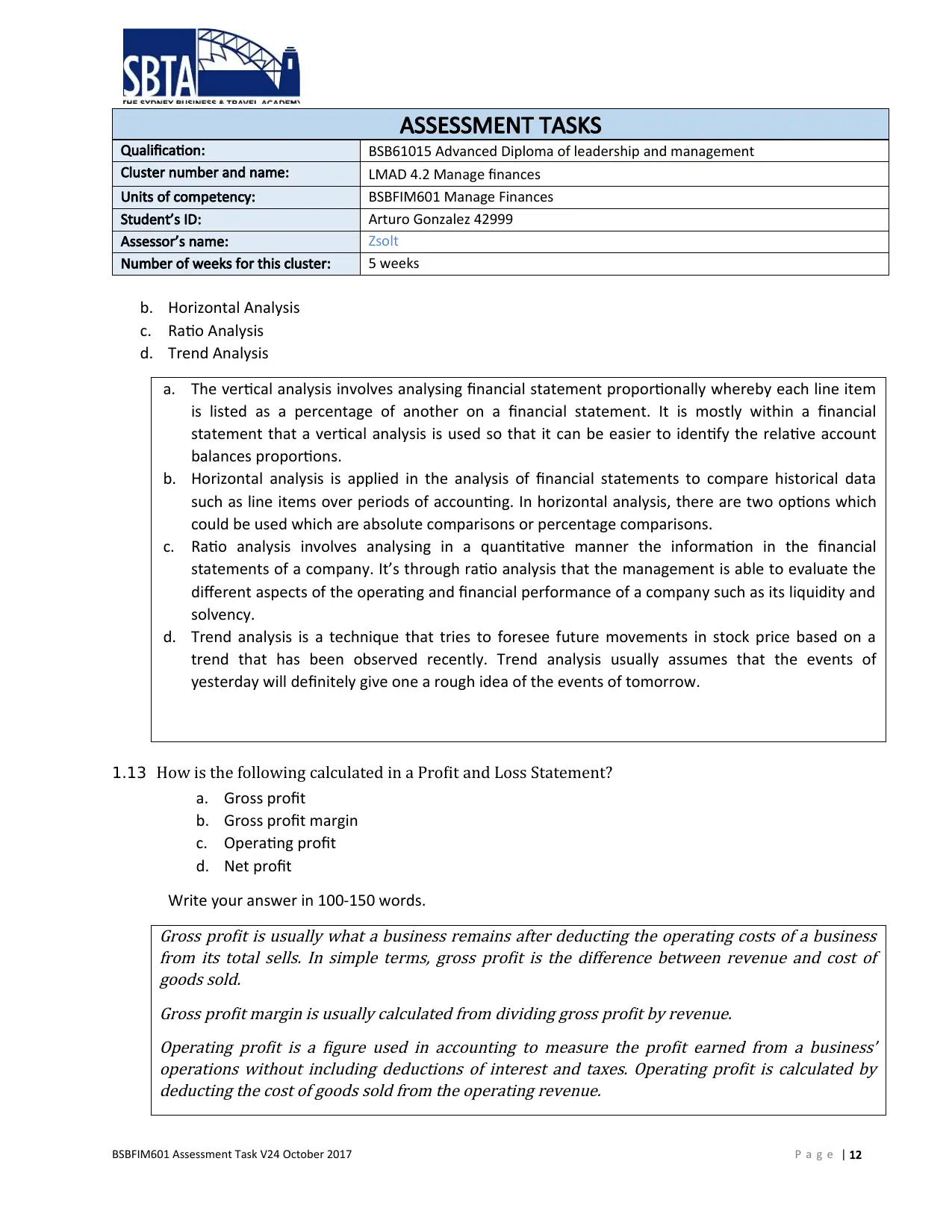
ASSESSMENT TASKS
Qualification: BSB61015 Advanced Diploma of leadership and management
Cluster number and name: LMAD 4.2 Manage finances
Units of competency: BSBFIM601 Manage Finances
Student’s ID: Arturo Gonzalez 42999
Assessor’s name: Zsolt
Number of weeks for this cluster: 5 weeks
b. Horizontal Analysis
c. Ratio Analysis
d. Trend Analysis
a. The vertical analysis involves analysing financial statement proportionally whereby each line item
is listed as a percentage of another on a financial statement. It is mostly within a financial
statement that a vertical analysis is used so that it can be easier to identify the relative account
balances proportions.
b. Horizontal analysis is applied in the analysis of financial statements to compare historical data
such as line items over periods of accounting. In horizontal analysis, there are two options which
could be used which are absolute comparisons or percentage comparisons.
c. Ratio analysis involves analysing in a quantitative manner the information in the financial
statements of a company. It’s through ratio analysis that the management is able to evaluate the
different aspects of the operating and financial performance of a company such as its liquidity and
solvency.
d. Trend analysis is a technique that tries to foresee future movements in stock price based on a
trend that has been observed recently. Trend analysis usually assumes that the events of
yesterday will definitely give one a rough idea of the events of tomorrow.
1.13 How is the following calculated in a Profit and Loss Statement?
a. Gross profit
b. Gross profit margin
c. Operating profit
d. Net profit
Write your answer in 100-150 words.Gross profit is usually what a business remains after deducting the operating costs of a business
from its total sells. In simple terms, gross profit is the difference between revenue and cost of
goods sold.
Gross profit margin is usually calculated from dividing gross profit by revenue.
Operating profit is a figure used in accounting to measure the profit earned from a business’
operations without including deductions of interest and taxes. Operating profit is calculated by
deducting the cost of goods sold from the operating revenue.
BSBFIM601 Assessment Task V24 October 2017 P a g e | 12
Qualification: BSB61015 Advanced Diploma of leadership and management
Cluster number and name: LMAD 4.2 Manage finances
Units of competency: BSBFIM601 Manage Finances
Student’s ID: Arturo Gonzalez 42999
Assessor’s name: Zsolt
Number of weeks for this cluster: 5 weeks
b. Horizontal Analysis
c. Ratio Analysis
d. Trend Analysis
a. The vertical analysis involves analysing financial statement proportionally whereby each line item
is listed as a percentage of another on a financial statement. It is mostly within a financial
statement that a vertical analysis is used so that it can be easier to identify the relative account
balances proportions.
b. Horizontal analysis is applied in the analysis of financial statements to compare historical data
such as line items over periods of accounting. In horizontal analysis, there are two options which
could be used which are absolute comparisons or percentage comparisons.
c. Ratio analysis involves analysing in a quantitative manner the information in the financial
statements of a company. It’s through ratio analysis that the management is able to evaluate the
different aspects of the operating and financial performance of a company such as its liquidity and
solvency.
d. Trend analysis is a technique that tries to foresee future movements in stock price based on a
trend that has been observed recently. Trend analysis usually assumes that the events of
yesterday will definitely give one a rough idea of the events of tomorrow.
1.13 How is the following calculated in a Profit and Loss Statement?
a. Gross profit
b. Gross profit margin
c. Operating profit
d. Net profit
Write your answer in 100-150 words.Gross profit is usually what a business remains after deducting the operating costs of a business
from its total sells. In simple terms, gross profit is the difference between revenue and cost of
goods sold.
Gross profit margin is usually calculated from dividing gross profit by revenue.
Operating profit is a figure used in accounting to measure the profit earned from a business’
operations without including deductions of interest and taxes. Operating profit is calculated by
deducting the cost of goods sold from the operating revenue.
BSBFIM601 Assessment Task V24 October 2017 P a g e | 12
⊘ This is a preview!⊘
Do you want full access?
Subscribe today to unlock all pages.

Trusted by 1+ million students worldwide
1 out of 50
Related Documents
Your All-in-One AI-Powered Toolkit for Academic Success.
+13062052269
info@desklib.com
Available 24*7 on WhatsApp / Email
![[object Object]](/_next/static/media/star-bottom.7253800d.svg)
Unlock your academic potential
Copyright © 2020–2025 A2Z Services. All Rights Reserved. Developed and managed by ZUCOL.





